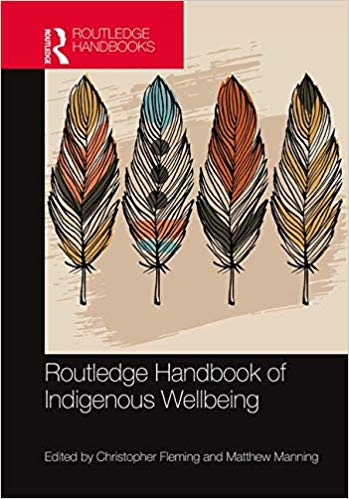Fleming, Christopher and Manning, Matthew - Routledge Handbook of Indigenous Wellbeing, Routledge Handbook of Indigenous Wellbeing London, Routledge, 2019 ISBN: 978-1-138-90917-5 (pp. 372)
Reviewed by Hart Cohen - Western Sydney University
Increasingly we find handbooks proliferating across a number of fields in the humanities, social and natural sciences and by diverse publishers. The Oxford Handbook list itself comprises handbooks across 15 disciplines, ranging from business and management to neuroscience. This Routledge Handbook, part of Routledge International Handbooks, is somewhat unique. Focusing on the concept of wellbeing, the handbook engages this concept through a prism of several disciplines from politics through law, psychology and anthropology. Wellbeing has emerged as a buzzword over several recent decades even if its first cited use is in the 1950s. It appears in UN agency reports in the 1990s and in research cases from about 2000. In this regard, it may be thought of as a specifically 21st century means of characterising and expanding on the concept of health.
The authors are careful to articulate the importance of defining the concept of ‘wellbeing’, but because their interest is in Indigenous wellbeing, to also defend their approach. The initial definition of ‘wellbeing’ states that it encompasses ‘… choices and activities aimed at achieving physical vitality, mental acuity, social satisfaction, a sense of accomplishment, and personal fulfilment’ (1). The evident condition of examining Indigenous wellbeing entails opening the field to a number of ‘domains’, variously defined as physical wellbeing, social and emotional wellbeing, economic wellbeing, cultural and spiritual wellbeing and subjective wellbeing. These domains sound like they were dialectically conceived in that the editors worked with their contributing authors and together emerged with this selection.
The Handbook spans the globe crossing the Americas, Oceania, Asia, circumpolar regions and Africa. To be sure, the breadth of this spread required a necessarily selective process to ensure representation from each rather than a focus on a particular geographical region. The 24 chapters cover a multitude of concerns that are brought into focus within a particular domain. For example, a chapter within the social and emotional domain offers a fairly general introduction to Sámi titled, ‘Wellbeing in Swedish Indigenous Sámi children and young people: Looking back and looking forward’. While the chapter is brief, there is a section on suicide in which the attribution to youth suicide among Sámi is about 10 percent higher than non-Sámi Swedish youth. Suicide rates are generally higher within Indigenous youth communities and there is a repetition of this concern in other chapters and domains found in the book.
In the section/domain of cultural and spiritual wellbeing, a chapter titled: ‘We have our own way: Exploring pathways for wellbeing among Inuit in Nunatsiavut, Labrador, Canada’, the authors, multiple researchers, combine a robust quantitative approach with a qualitative assessment of the important of Inuit value systems to wellbeing. Specifically, they refer to the massive changes Inuit people have been subjected to and how embedding a relationship to the land and cultural traditions fostered strong wellbeing outcomes. Moreover, many Inuit express the importance of community and family – ‘… a complementary network of community-minded individuals, for supporting individual and collective wellness’ (234).
The editors of the Handbook are also authors and contribute several chapters to the discussions. They also signal both a valorisation of Indigenous wellbeing as well as how the lack of wellbeing can be traced to multiple experiences of colonialism that resulted in cultural denial, economic deprivation and social displacement. Thus, this handbook is able to bind the root causes of many of the research cases referred to within the colonial experience. At the same time, it shows that the way forward to improving Indigenous wellbeing is diverse and grounded in a research ethos where Indigenous peoples are sovereign in how they inform and apply best practice for achieving wellbeing ‘in their own way’.
About the reviewer
Dr Hart Cohen is Professor in Media Arts in the School of Humanities and Communication Arts at Western Sydney University, Australia where he is also a member of the Institute for Culture and Society. He has published widely in the field of visual anthropology, communications and film studies. Professor Cohen is co-author of Screen Media Arts: An Introduction to Concepts and Practices for Oxford University Press (2009) and founding editor of the Global Media Journal (Australian Edition). His most recent book is The Strehlow Collection: Explorations in Old and New Media (2018, Routledge).
Email: h.cohen.westernsydney.edu.au

